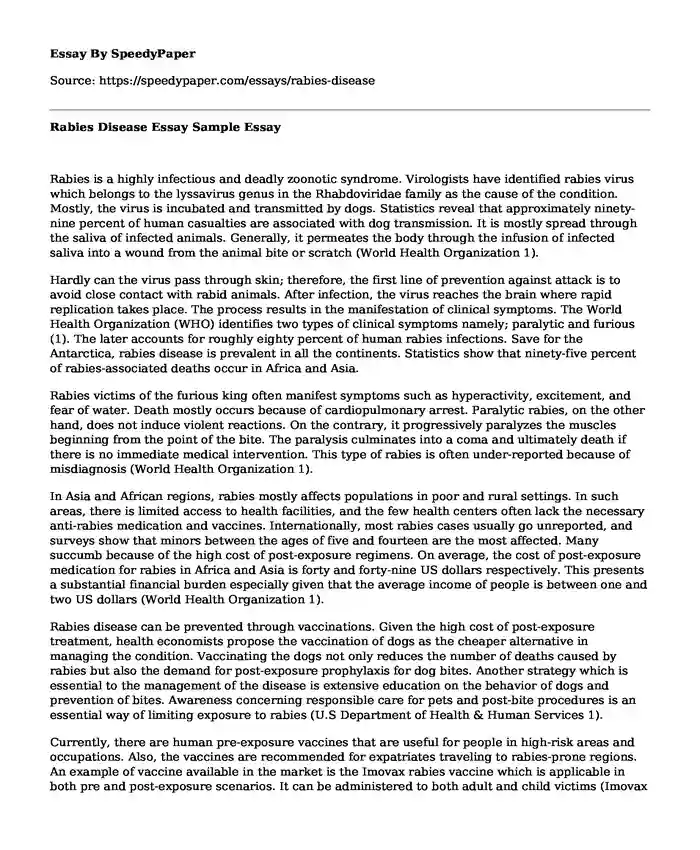Rabies is a highly infectious and deadly zoonotic syndrome. Virologists have identified rabies virus which belongs to the lyssavirus genus in the Rhabdoviridae family as the cause of the condition. Mostly, the virus is incubated and transmitted by dogs. Statistics reveal that approximately ninety-nine percent of human casualties are associated with dog transmission. It is mostly spread through the saliva of infected animals. Generally, it permeates the body through the infusion of infected saliva into a wound from the animal bite or scratch (World Health Organization 1).
Hardly can the virus pass through skin; therefore, the first line of prevention against attack is to avoid close contact with rabid animals. After infection, the virus reaches the brain where rapid replication takes place. The process results in the manifestation of clinical symptoms. The World Health Organization (WHO) identifies two types of clinical symptoms namely; paralytic and furious (1). The later accounts for roughly eighty percent of human rabies infections. Save for the Antarctica, rabies disease is prevalent in all the continents. Statistics show that ninety-five percent of rabies-associated deaths occur in Africa and Asia.
Rabies victims of the furious king often manifest symptoms such as hyperactivity, excitement, and fear of water. Death mostly occurs because of cardiopulmonary arrest. Paralytic rabies, on the other hand, does not induce violent reactions. On the contrary, it progressively paralyzes the muscles beginning from the point of the bite. The paralysis culminates into a coma and ultimately death if there is no immediate medical intervention. This type of rabies is often under-reported because of misdiagnosis (World Health Organization 1).
In Asia and African regions, rabies mostly affects populations in poor and rural settings. In such areas, there is limited access to health facilities, and the few health centers often lack the necessary anti-rabies medication and vaccines. Internationally, most rabies cases usually go unreported, and surveys show that minors between the ages of five and fourteen are the most affected. Many succumb because of the high cost of post-exposure regimens. On average, the cost of post-exposure medication for rabies in Africa and Asia is forty and forty-nine US dollars respectively. This presents a substantial financial burden especially given that the average income of people is between one and two US dollars (World Health Organization 1).
Rabies disease can be prevented through vaccinations. Given the high cost of post-exposure treatment, health economists propose the vaccination of dogs as the cheaper alternative in managing the condition. Vaccinating the dogs not only reduces the number of deaths caused by rabies but also the demand for post-exposure prophylaxis for dog bites. Another strategy which is essential to the management of the disease is extensive education on the behavior of dogs and prevention of bites. Awareness concerning responsible care for pets and post-bite procedures is an essential way of limiting exposure to rabies (U.S Department of Health & Human Services 1).
Currently, there are human pre-exposure vaccines that are useful for people in high-risk areas and occupations. Also, the vaccines are recommended for expatriates traveling to rabies-prone regions. An example of vaccine available in the market is the Imovax rabies vaccine which is applicable in both pre and post-exposure scenarios. It can be administered to both adult and child victims (Imovax 1). In summary, rabies disease is infectious and requires proper and timely intervention to prevent deaths. The availability of vaccines both for dogs and humans make it a reasonably manageable condition. Additionally, sufficient knowledge of the disease transmission mechanism is vital to all prevention efforts.
Works Cited
"Imovax (Rabies Vaccine): Side Effects, Interactions, Warning, Dosage & Uses." RxList, 20 July 2018, www.rxlist.com/imovax-drug.htm.
U.S Department of Health & Human Services. "Rabies." 11 October 2018. Vaccines. 11 October 2018 <https://www.vaccines.gov/diseases/rabies/index.html>.
World Health Organization. Rabies. 13 September 2018. 11 October 2018 <http://www.who.int/news-room/fact-sheets/detail/rabies>.
Cite this page
Rabies Disease Essay Sample. (2022, Sep 01). Retrieved from https://speedypaper.com/essays/rabies-disease
Request Removal
If you are the original author of this essay and no longer wish to have it published on the SpeedyPaper website, please click below to request its removal:
- Free Essay on Personality Disorder - Case Analysis of Sally
- Issues Regarding Police Interaction with Minority Populations, Police Brutality Essay Sample
- Social Media Plan/Implementation
- Essay Sample Describing Social Work Practice with Hispanic Families
- Psychology Thought Paper, Free Example for Students
- Curriculum: Differentiating Instruction for Learner Understanding. Essay Sample
- Free Essay Example: Discrimination Against Women in Sports
Popular categories





